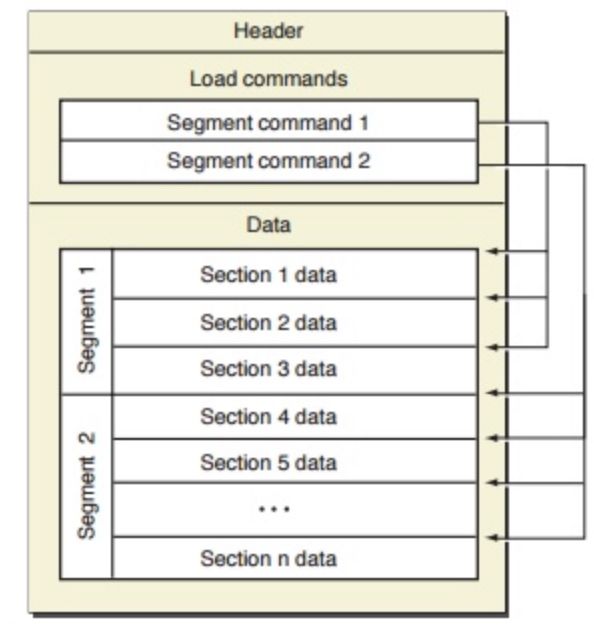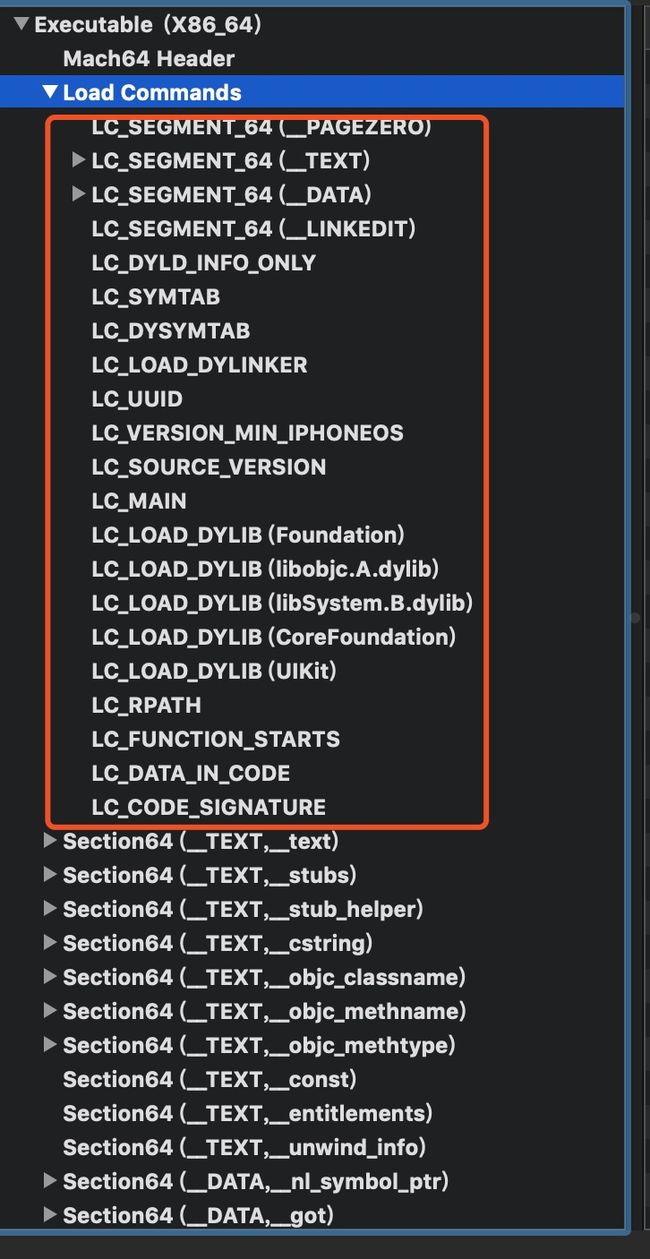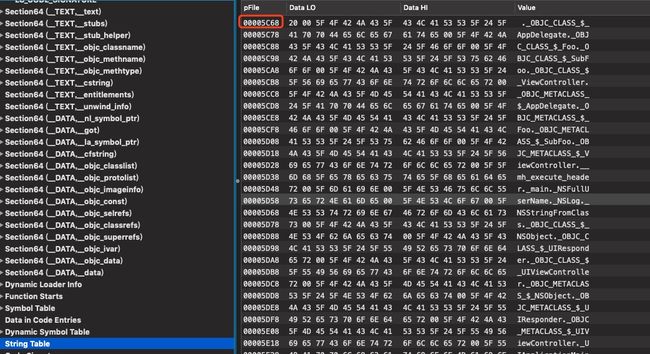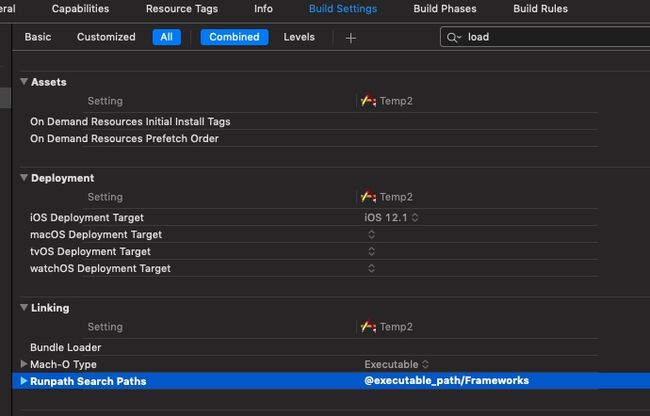[TOC]
简介
MachO文件是mac平台上一类文件的简称,它的类型有以下种类,可以在#import 文件中找到
#define MH_OBJECT 0x1 /* relocatable object file */
#define MH_EXECUTE 0x2 /* demand paged executable file */
#define MH_FVMLIB 0x3 /* fixed VM shared library file */
#define MH_CORE 0x4 /* core file */
#define MH_PRELOAD 0x5 /* preloaded executable file */
#define MH_DYLIB 0x6 /* dynamically bound shared library */
#define MH_DYLINKER 0x7 /* dynamic link editor */
#define MH_BUNDLE 0x8 /* dynamically bound bundle file */
#define MH_DYLIB_STUB 0x9 /* shared library stub for static */
/* linking only, no section contents */
#define MH_DSYM 0xa /* companion file with only debug */
/* sections */
#define MH_KEXT_BUNDLE 0xb /* x86_64 kexts */
列举一些常见的类型
| 文件类型 | 含义 |
|---|---|
| MH_OBJECT | 目标文件,平时.o结尾的文件 |
| MH_EXECUTE | 可执行文件,我们平时编译后的包中的执行文件 |
| MH_DYLIB | 一些动态库,该文件夹下很多/usr/lib/xxx.dylib |
| MH_DSYM | 符号文件,编译成功后XXX.app.dSYM |
一、MachO的分类
这里准备了一些macho文件,分别通过MachOView工具来看看,如果你的MachOView会崩溃,点击下载这个
分别用MachOView打开如下
二、MachO的组成
每个Macho文件都会有个Header对这个Macho进行整体描述,这个header根据你打包的选择的架构又分为Fat Header 和 Mach Header,先介绍下如何生成这2个文件类型
Architectures和valid Architectures 的交集就是最后打的包的架构,Architectures后面是标准的架构,我把项目设置为iOS8选择真机,将build改成release,会编译出一开始的展示的MochO_arm_fat文件放到MachOView中如图
然后选择模拟器将build改成debug ,build会出现MochO_x86,结果如图
2.1 fat_header
2.1.1 fat_header 结构
struct fat_header {
uint32_t magic; /* FAT_MAGIC or FAT_MAGIC_64 */
uint32_t nfat_arch; /* number of structs that follow */
};
-
magic: 描述文件类型 值分为2组分别为FAT_CIGAM(0xbebafeca)、FAT_MAGIC(0xcafebabe)和FAT_CIGAM_64(0xbfbafeca)、FAT_MAGIC_64(0xcafebabf),值也就是大小端的区别; -
nfat_arch:描述当前fat有多少个架构。
2.1.2 fat_arch 结构
2.1.1 说到fat_header的nfat_arch会描述有多少个架构,其实架构的类型就是fat_arch类型的,结构如下
struct fat_arch {
cpu_type_t cputype; /* cpu specifier (int) */
cpu_subtype_t cpusubtype; /* machine specifier (int) */
uint32_t offset; /* file offset to this object file */
uint32_t size; /* size of this object file */
uint32_t align; /* alignment as a power of 2 */
};
-
cputype:说明CPU的类型一般有CPU_TYPE_X86、CPU_TYPE_X86_64、CPU_TYPE_ARM64、CPU_TYPE_ARM; -
cpusubtype: 对cpu类型的具体划分一般有CPU_SUBTYPE_I386_ALL、CPU_SUBTYPE_X86_ALL、CPU_SUBTYPE_ARM_V7、CPU_SUBTYPE_ARM_V7S; -
offset: 当前架构的偏移量; -
size:当前架构的大小; -
align:对齐大小。
通过MachOView来看下MochO_arm_fat的fat_header
也可以用otool查看
otool -f /Users/fangshufeng/Desktop/thirdPart/macho/MochO/MochO/exccute/
MochO_arm_fat
Fat headers
fat_magic 0xcafebabe
nfat_arch 2
architecture 0
cputype 12
cpusubtype 9
capabilities 0x0
offset 16384
size 112048
align 2^14 (16384)
architecture 1
cputype 16777228
cpusubtype 0
capabilities 0x0
offset 131072
size 108624
align 2^14 (16384)
上面可以看到
架构architecture 0的偏移地址是16384,也就是16进制的0x4000;
架构architecture 1的偏移地址是131072,也就是16进制的0x20000;
我们来看下是否正确
正好是要的值
2.2 mac_header
对于不是fat的Macho文件一开始的内容就是mac_header
2.2.1 结构
struct mach_header {
uint32_t magic; /* mach magic number identifier */
cpu_type_t cputype; /* cpu specifier */
cpu_subtype_t cpusubtype; /* machine specifier */
uint32_t filetype; /* type of file */
uint32_t ncmds; /* number of load commands */
uint32_t sizeofcmds; /* the size of all the load commands */
uint32_t flags; /* flags */
};
magic、cputype、cpusubtype:同上;filetype:Macho文件的类型,也就是文章一开始列举的类型;ncmds:接下来load commands的数量,后面会介绍;sizeofcmds:接下来load commands的大小,后面会介绍;-
flags:文件的表示信息,值如下:/* Constants for the flags field of the mach_header */ #define MH_NOUNDEFS 0x1 /* the object file has no undefinedreferences */ #define MH_INCRLINK 0x2 /* the object file is the output of an incremental link against a base file and can't be link edited again */ #define MH_DYLDLINK 0x4 /* the object file is input for the dynamic linker and can't be staticly link edited again */ #define MH_BINDATLOAD 0x8 /* the object file's undefined references are bound by the dynamic linker when loaded. */ #define MH_PREBOUND 0x10 /* the file has its dynamic undefined references prebound. */ #define MH_SPLIT_SEGS 0x20 /* the file has its read-only and read-write segments split */ #define MH_LAZY_INIT 0x40 /* the shared library init routine is
截图如下
同样使用otool也是可以的
➜ MochO otool -h exccute/MochO_x86
Mach header
magic cputype cpusubtype caps filetype ncmds sizeofcmds flags
0xfeedfacf 16777223 3 0x00 2 21 3176 0x00200085
➜ MochO
上面显示该文件的类型为MH_EXECUTE,Load Commands的数量为21个,数一下确实是21个。
也就是说mach_header更多的是对load Commands的描述
2.3 load Commands
load Commands是由很多的LC_Type组成的,而LC_Type有很多种,可在文件loader.h文件中查看,这边就列出前几种
/* Constants for the cmd field of all load commands, the type */
#define LC_SEGMENT 0x1 /* segment of this file to be mapped */
#define LC_SYMTAB 0x2 /* link-edit stab symbol table info */
#define LC_SYMSEG 0x3 /* link-edit gdb symbol table info (obsolete) */
[...]
而每个LC_Type都会有一个头部load_command结构如下
struct load_command {
uint32_t cmd; /* type of load command */
uint32_t cmdsize; /* total size of command in bytes */
};
是的就是对segment的描述
-
cmd: 当前load command的类型; -
cmdsize:load command的大小。
也就是下面这张图
2.3.1 LC_SEGMENT
为了方便管理,程序在内存中是分段管理的,先来看看LC_Type其中一种LC_SEGMENT的结构
struct segment_command { /* for 32-bit architectures */
uint32_t cmd; /* LC_SEGMENT */
uint32_t cmdsize; /* includes sizeof section structs */
char segname[16]; /* segment name */
uint32_t vmaddr; /* memory address of this segment */
uint32_t vmsize; /* memory size of this segment */
uint32_t fileoff; /* file offset of this segment */
uint32_t filesize; /* amount to map from the file */
vm_prot_t maxprot; /* maximum VM protection */
vm_prot_t initprot; /* initial VM protection */
uint32_t nsects; /* number of sections in segment */
uint32_t flags; /* flags */
};
-
cmd和cmdsize: 就是上面的load_command类型; -
segname:就是当前segment的名称 -
vmaddr:在虚拟内存中的地址,这个很重要的,以后会介绍到 -
vmsize:在虚拟内存中所占用的大小; -
fileoff:在文件中的偏移量; -
filesize:在文件中的大小,注意和vmaddr、vmsize区别 -
maxprot:表示页面所需要的最高内存保护; -
initprot:表示页面初始的内存保护; -
nsects: 当前segment有多少个sections -
flags:表示段的标志信息。
常见的LC_SEGMENT有以下几种
#define SEG_PAGEZERO "__PAGEZERO"
#define SEG_TEXT "__TEXT" /* the tradition UNIX text segment */
#define SEG_DATA "__DATA" /* the tradition UNIX data segment */
2.3.1.1 __PAGEZERO
这是一个不可读、不可写、不可执行的空间,能够在空指针访问时抛出异常。这个段的大小,32位上是 0x4000,64位上0000000100000000也就是 4G,4GB 并不是文件的真实大小,但是规定了进程地址空间的前 4GB 被映射为 不可执行、不可写和不可读,是从0(也是NULL指针的位置)开始的,这就是为什么当读写一个 NULL 指针或更小的值时会得到一个 EXC_BAD_ACCESS 错误。
内容如下
2.3.1.2 __TEXT
这是程序的代码段,该段是可读可执行,但是不可写。常见的section如下
2.3.1.3 __DATA
数据段,包含了可读写数据。常见的section如下
2.3.2 LC_DYLD_INFO_ONLY
LC_DYLD_INFO_ONLY和LC_DYLD_INFO是同一个结构
struct dyld_info_command {
uint32_t cmd; /* LC_DYLD_INFO or LC_DYLD_INFO_ONLY */
uint32_t cmdsize; /* sizeof(struct dyld_info_command) */
uint32_t rebase_off; /* file offset to rebase info */
uint32_t rebase_size; /* size of rebase info */
uint32_t bind_off; /* file offset to binding info */
uint32_t bind_size; /* size of binding info */
uint32_t weak_bind_off; /* file offset to weak binding info */
uint32_t weak_bind_size; /* size of weak binding info */
uint32_t lazy_bind_off; /* file offset to lazy binding info */
uint32_t lazy_bind_size; /* size of lazy binding infs */
uint32_t export_off; /* file offset to lazy binding info */
uint32_t export_size; /* size of lazy binding infs */
};
这个command是dyld在将二进制文件装载到内存链接的时候使用的
- 前面2个不介绍了,
rebase:由于Macho被加载到内存的时候首地址不是固定的,是随机分配的,针对这个做修正的; -
bind:在链接的时候对一些符号进行绑定的,比如我们用到了UIKIT框架的api,但是二进制中又没有这个符号,此刻就是做这个对应的工作; -
lazy_bind:就是一开始不必要立即绑定,后面用到的时候再绑定。
内容如下
可以通过偏移量找到对应的地方
2.3.3 LC_SYMTAB
这里面记录着所有的符号信息
struct symtab_command {
uint32_t cmd; /* LC_SYMTAB */
uint32_t cmdsize; /* sizeof(struct symtab_command) */
uint32_t symoff; /* symbol table offset */
uint32_t nsyms; /* number of symbol table entries */
uint32_t stroff; /* string table offset */
uint32_t strsize; /* string table size in bytes */
};
-
symoff:符号表的偏移量; -
nsyms:符号表的元素的数量; -
stroff:符号的字符串的偏移量; -
strsize:所占的字节数。
2.3.3.1 查看Symbol Table
上面说到symbol的偏移量为21568也就是0x0000 5440
选择如下
看到下图
Symbol Table装着都是结构nlist_64或者nlist可以see
struct nlist_64 {
union {
uint32_t n_strx; /* index into the string table */
} n_un;
uint8_t n_type; /* type flag, see below */
uint8_t n_sect; /* section number or NO_SECT */
uint16_t n_desc; /* see */
uint64_t n_value; /* value of this symbol (or stab offset) */
};
-
n_strx: 在String Table中的索引值; -
n_type: 可选的值有N_STAB、N_PEXT、N_TYPE、N_EXT; -
n_sect:section的类型,要么就是NO_SECT; -
n_desc: -
n_value: 符号对应的地址
这里以AppDelegate的符号_OBJC_CLASS_$_AppDelegate来演示
根据图得出以下信息:
-
n_sect显示位于__DATA,__objct_data; -
value显示地址为0x100003F48。
跳到对应的地址看到确实是我们要找的:
具体的数据如图
读出以下信息:
-
_OBJC_CLASS_$_AppDelegate的isa是OBJC_METACLASS$_AppDelegate; - 父类是
UIResponder - 此时的缓存是空
- 缓存的数量为0
- 当前类相关的信息在地址
0x100003DC0;
到这是不是觉得特别熟悉呢,我们把AppDelegate的代码用c++看下
xcrun -sdk iphoneos clang -arch arm64 -rewrite-objc AppDelegate.m
可以看到
extern "C" __declspec(dllexport) struct _class_t OBJC_CLASS_$_AppDelegate __attribute__ ((used, section ("__DATA,__objc_data"))) = {
0, // &OBJC_METACLASS_$_AppDelegate,
0, // &OBJC_CLASS_$_UIResponder,
0, // (void *)&_objc_empty_cache,
0, // unused, was (void *)&_objc_empty_vtable,
&_OBJC_CLASS_RO_$_AppDelegate,
};
static void OBJC_CLASS_SETUP_$_AppDelegate(void ) {
[...这里删除了元类的信息]
OBJC_CLASS_$_AppDelegate.isa = &OBJC_METACLASS_$_AppDelegate;
OBJC_CLASS_$_AppDelegate.superclass = &OBJC_CLASS_$_UIResponder;
OBJC_CLASS_$_AppDelegate.cache = &_objc_empty_cache;
}
和我们的工具看到的不谋而合
我们继续跳到0x100003DC0看下
确实看到了我们要的信息,而右边的又是什么呢,由刚才的C++代码可以知道0x100003DC0就是_OBJC_CLASS_RO_$_AppDelegate的地址
看下_class_ro_t的结构
struct _class_ro_t {
unsigned int flags;
unsigned int instanceStart;
unsigned int instanceSize;
const unsigned char *ivarLayout;
const char *name;
const struct _method_list_t *baseMethods;
const struct _objc_protocol_list *baseProtocols;
const struct _ivar_list_t *ivars;
const unsigned char *weakIvarLayout;
const struct _prop_list_t *properties;
};
这个结构也即是我们截图的内容真好匹配
static struct _class_ro_t _OBJC_CLASS_RO_$_AppDelegate __attribute__ ((used, section ("__DATA,__objc_const"))) = {
0,
__OFFSETOFIVAR__(struct AppDelegate, _window),
sizeof(struct AppDelegate_IMPL),
0,
"AppDelegate",
(const struct _method_list_t *)&_OBJC_$_INSTANCE_METHODS_AppDelegate,
(const struct _objc_protocol_list *)&_OBJC_CLASS_PROTOCOLS_$_AppDelegate,
(const struct _ivar_list_t *)&_OBJC_$_INSTANCE_VARIABLES_AppDelegate,
0,
(const struct _prop_list_t *)&_OBJC_$_PROP_LIST_AppDelegate,
};
所以到这里我们可以知道该类的所有信息了,比如我们想看看它得方法列表,由截图可以知道地址为0x0000000100003C60
每一个item对应的就是_objc_method
struct _objc_method {
struct objc_selector * _cmd;
const char *method_type;
void *_imp;
};
比如我们现在想到拿到方法- (BOOL)application:(UIApplication *)application didFinishLaunchingWithOptions:(NSDictionary *)launchOptions的名称,看图可以知道方法的字符串地址为0000000100001C90
果然找到了,其它的信息可以自己尝试去找找。更多关于类方面的知识可以看下我之前的oc主题相关的文章,现在文章已经很长了,不说这个了。
2.3.3.2 查看String Table
2.3.4 LC_DYSYMTAB
这里记录着所有的动态链接时需要的符号信息
同样我们找到00005C10
还有很多没有截取了,比如这些_NSFullUserName这些在链接的时候回去动态解析这些符号表
这个Indirect Symbols包含了所有和动态库相关的符号,包括__DATA,__la_symbol_ptr、__DATA,__nl_symbol_ptr、__DATA,__got,这个表有以下用处:
- 通过这个表的
Symbol可以找到在符号表Symbol Table的位置,从而在字符串表String Table中找到名称; - 通过这个表的
Indirect Address可以在__DATA,__la_symbol_ptr、__DATA,__nl_symbol_ptr、__DATA,__got中找到方法的地址
fishook就用到了这个,后面我会单独来介绍这个库的实现原理
2.3.5 LC_MAIN
指定了main函数的入口地址
加载到内存后增加头部地址就是函数的真正地址了
2.3.6 LC_LOAN_DYLIB
描述了一些动态库相关的信息
struct dylib {
union lc_str name; /* library's path name */
uint32_t timestamp; /* library's build time stamp */
uint32_t current_version; /* library's current version number */
uint32_t compatibility_version; /* library's compatibility vers number*/
};
struct dylib_command {
uint32_t cmd; /* LC_ID_DYLIB, LC_LOAD_{,WEAK_}DYLIB,LC_REEXPORT_DYLIB */
uint32_t cmdsize; /* includes pathname string */
struct dylib dylib; /* the library identification */
};
2.3.7 LC_RPATH
Runpath的简写
程序运行链接路径
xcode中可以看到
2.3.8 LC_FUNCTION_STARTS
方法是从哪里开始的
和解析出来的顺序也是一致的
2.3.9 LC_CODE_SINGATURE
签名相关的信息
找到地方0x67E0
关于签名的后面打算单独写一篇
2.4 section
结构如下
struct section_64 { /* for 64-bit architectures */
char sectname[16]; /* name of this section */
char segname[16]; /* segment this section goes in */
uint64_t addr; /* memory address of this section */
uint64_t size; /* size in bytes of this section */
uint32_t offset; /* file offset of this section */
uint32_t align; /* section alignment (power of 2) */
uint32_t reloff; /* file offset of relocation entries */
uint32_t nreloc; /* number of relocation entries */
uint32_t flags; /* flags (section type and attributes)*/
uint32_t reserved1; /* reserved (for offset or index) */
uint32_t reserved2; /* reserved (for count or sizeof) */
uint32_t reserved3; /* reserved */
};
这里只列举了section64位的,section可以自己在#include 查看
-
sectname:当前section的名字; -
segname:位于哪个segment; -
addr:当前section在内存中的地址; -
size:当前的section所占的内存大小; -
offset:当前section的偏移量; -
reloff: 抱歉暂时没找到实际的用处,不做解释,以免误人子弟; -
nreloc:这个就是表示上面reloff的数量; -
flags: 这个是当前section的标志位,包括sectionType和sectionAttribute,一个section可以有多个属性,但是只能有一个类型,这个很好理解了,可以通过位运算分别获取类型和属性,(section->flags & SECTION_TYPE、section->flags & SECTION_ATTRIBUTES -
reserved1:这是个保留字段,它可以表示偏移量也可以用来表示索引,一般用来表示Indirect Symbol Index也就是间接索引表的位置,你可以在__got、__subs等中可以查看; -
reserved3:也是个保留字段,一般表示数量的,比如在__subssection中就表示subs的个数; -
reserved3:这个真是个保留字段了,暂时没什么用处
随意截取一个section看下结构吧
本篇完。










































